The Doran 360M TPMS
The Doran 360M Motorcycle Tire Pressure System is a reasonably priced, motorcycle-friendly, assemblage of hardware and software.
The system consists of wheel-mounted sensors and an LCD display.
The combination lets you know at a glance what the air pressure values are for each tire, and also alerts you, in real time, to pressure problems when they occur.
TPMS Background
Since this is only webBikeWorld’s second foray into the world of TPMS, and the first regarding a unit intended for on-bike display, a little background is in order.
“TPMS” is the abbreviation for Tire Pressure Monitoring System(s) (and so, like “PIN number,” saying “TPMS system” is redundant).
TPMS have been available in certain cars for decades, and have been required in new cars in the U.S. since 2007.
This mandate was spurred on by a spate of SUV rollovers that were attributed, at least in some measure, to under-inflated tires.
The purpose of car-based TPMS is to alert the driver to an under-inflated tire, as a result of neglect, a puncture, etc.
If that’s the case, a dashboard warning light will come on; this kind of light is typically an orange outline of a tire’s cross-section, looking very much like a horseshoe, open at the top.
TPMS Motorcycle Usage
As motorcycle riders and with only two wheels, with just two small contact patches to “keep the shiny side up,” proper inflation is even more important to us.
OK, you already know that, and you also know that you should check your tire pressure often, perhaps before every ride.
But do you do that? I didn’t think so. That takes more diligence and effort than most of us can muster.
Unlike most car systems, which don’t provide actual pressure information, most motorcycle TPMS provide specific, i.e., numerical, readings.
This is the lazy – or smart – person’s substitute for getting down and taking off valve-stem caps, angling your tire gauge properly amidst brake disks and who knows what else, and getting a reading.
In addition to a pre-ride check, it’s fair to say that we riders are in more peril than four-wheel drivers in the event that a tire picks up a nail, and starts to lose air, during the course of a ride. That’s something you’d want to know about, and post haste, right?
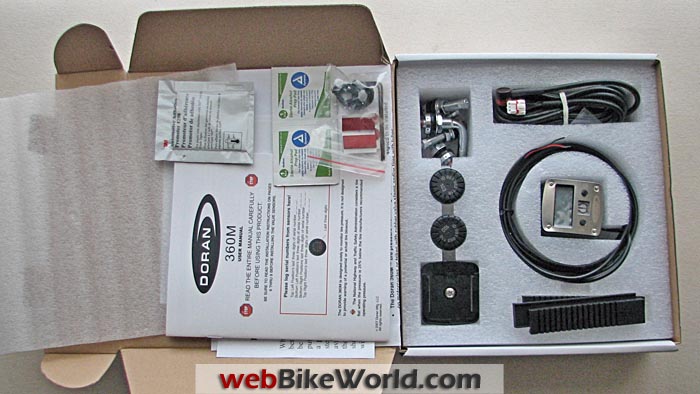
Where to Buy Doran 360M TPMS
Check Reviews & Prices on AmazonSee More: Motorcycle Accessories, Motorcycle Tire, Motorcycle Helmets
Motorcycle TPMS Configuration Decisions
If you’re convinced that getting a TPMS is the way to go, you have several choices to make. One choice would be to just buy a bike that includes a TPMS as an option or as standard equipment.
Most BMWs these days give you the option of purchasing a built-in TPMS. Kawasaki’s Concours 14 comes standard with a TPMS; this is becoming increasingly common as an option, undoubtedly available on others brands and models that I’m not familiar with.
Late-model Gold Wings also come with TPMS, but that system is, surprise, more car-like. That is, it doesn’t tell you actual pressures, just that the pressure is amiss. Not ideal for bikers, if you ask me.
Warning: motorcycle TPMS are not compatible with tube-type tires, unless the tubes have metal valve stems and those metal stems are securely anchored to the rim.
The external sensors (see below) that you’d have to use would put too much stress on the rubber valve stems.
Manufacturers specifically warn against using rubber valve stems in conjunction with external sensors (and even provide metal valve stems, in the case of the Doran 360M – see below).
If they omit such a proscription, many users have found that out for themselves, the hard way, that they should’ve used metal valve stems.
Not in the market for a new bike? Your first decision concerns where you want the sensor. As on car systems, the pressure sensors communicate with a central module via RF (radio frequency) signals.
They can be mounted internally, i.e., inside the wheel rim, where the air goes.
Or, you can choose a system that uses external sensors, i.e., mounted on the valve stem, in place of the valve-stem cap.
This latter method is not just for bikes; some of the aftermarket companies that make TPMS intend that external sensors also be used for RVs and trailers, for example.
There are pros and cons to both options. Internal sensors can’t be stolen nearly as easily as external ones, they live in a more protected environment, and they don’t have to be removed when adding air.
Also (and this may be a critical factor for some bikes) internal sensors don’t present a clearance issue.
That is, keep in mind that external sensors are a whole lot bigger than the valve-stem caps they replace; with either straight or angled valve stems there may not be room for the sensors to clear brake calipers, for instance.
This is a rare situation, but keep it in mind, especially if you have one of those BMW models in which the valve stem is attached to a “spoke” support member instead of the rim proper.
On the other hand, internal sensors are sometimes more expensive than external sensors if they break, and even replacing their batteries requires removal of the tire.
Also, some units may not be compatible with balance beads, if you use them in your tires.
Regarding the external sensors, some of them have user-replaceable batteries, while some are factory sealed, requiring that you buy a new sensor when the battery dies in one.
Another decision you have to make concerns what type of display module you want. These range from fairly large displays to tiny displays intended for a keychain or pocket, such as the TireGard Wireless TPMS (review).
If you have the impression by now that some of these “motorcycle” TPMS are thinly disguised systems really intended for use inside a car or RV, you’d be right. This brings up another issue.
Some of these display modules are not waterproof. You can live with that, or add silicone caulking beads in strategic locations, or resort to a kitchen baggy in the event of rain. Or buy one that is waterproof.
And you have to decide how you want the display module powered.
This is not an issue for the battery-only keychain-sized displays, but for the larger, bike-mounted, displays, some use an internal battery and some can get their power from the bike.
Hang on, we’re getting there. Just a few more factors…
Another consideration concerns temperature. You know that you check (and add) air with “cold” tires, i.e., before you start riding, not during or after, right?
That’s because the heat generated by friction and side-wall flex will raise the temperature – and hence pressure – of the air inside your tires.
I mention this because some TPMS are sophisticated enough that they have temperature-compensating displays.
That is, if a tire was at 40 PSI when you started out, and it’s now at 50 PSI because you’re rolling right along and the temperature inside the tire is, say, 140 degrees, the display will still show 40 PSI.
And maybe another function will also show you the temperature.
The theory here is that if the unit has temperature compensation, you will need to lose less air before an alert is issued. That is, without such compensation, pressure will have to first fall through the heat-expanded range, and then dip down to the threshold warning pressure.
My own belief is that this isn’t significant if your starting pressure was OK; a small leak will eventually cause an alert anyway, and a quick leak will, in most systems, trigger a separate loss-per-unit-time alert, regardless of the actual pressure numbers.
Next, some sensors have a rotation-based startup mechanism.
That is, these sensors don’t even think about transmitting data until the tire starts spinning. The upside of such systems is that sensor batteries will probably last longer.
The downside is that you can’t see how your tires are doing while the bike’s just sitting there in the garage, i.e., without actually starting out on your journey.
Some of those auto-on systems may let you display pressures without going anywhere yet, but those values may be the ones that the system last encountered when operational, i.e., when you parked the bike last night.
Thus, if you developed a leak overnight, the problem won’t be revealed just yet).
Along these lines, some TPMS provide upper warnings for pressure and perhaps temperature. Whether you want that information or would know what to set those thresholds at is another matter.
OK, last criterion: how many sensors do you need? You’ll need three sensors if you have a trike or sidecar. Or maybe you have a trailer, with a wheel or two, that you want to monitor.
Or maybe you have an air shock you want to keep tabs on (and I’m not making that up; some folks really do that, and I was considering it myself).
So, if you’re looking at one of the true motorcycle-oriented systems, can it handle your sensor requirement?
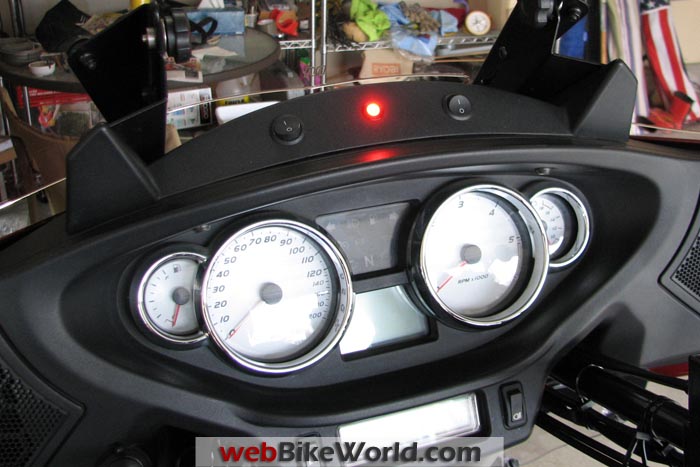
The Doran 360M TPMS
I spent many hours over the course of the last couple of years researching TPMS in general, and comparing and contrasting different systems in terms of the factors I’ve just discussed.
So while those factors are still fresh in your mind, let me tell you why I chose the Doran 360M TPMS.
After that, I’ll describe its installation and operation in more detail. And after all of that, you can then do your own additional research, accord your own weights to the various criteria, and make up your own mind regarding which system to buy.
The good features of the Doran 360M:
External sensors. Actually, the Doran 360M uses the same sensors, whether you mount them internally or externally; they even include two sets of special metal valve stems (see below) that have threads on the inside, as well as the outside, portions of the stems.
But my point is that I did not want to use internal sensors. I don’t want to have to take tires off (or wait for my next tire change) when a battery goes. If you do your own tire changing, maybe this isn’t an issue.
Waterproof display. The 360M is one of the very few systems that really seem to be meant for bikes, and having a waterproof display goes along with that. I have a badly aging GPS that I’m sometimes forced to cover with a clear plastic bag, and that’s really a dumb system.
Bike power. This is another biker-friendly aspect, i.e., the 360M has a built-in wire pair for getting bike power; it’s 12V or nothing here.
Always on. Well, you can use switched power from the bike (and I’ll discuss this more fully in a bit), but if you don’t you will have a “current” reading (more on that in a minute, too).
The point here is that I didn’t want a system that requires the tires to be rotating to activate; I want to see the pressures before I go for a ride.
Real-time alerts. This is not just a system for a pre-ride check of your tire pressures; this system is designed to let you know when a problem has just occurred.
Alert light. In addition to its control module, the 360M includes a red LED. This is designed to get your attention if there’s a problem with your tires, and, if you desire, also enables you to essentially dispense with the control module (for theft prevention, for instance).
Again, Doran has motorcyclists in mind.
And here are some aspects of the 360M that I don’t particularly care for:
The batteries in the sensors are not user-replaceable. When one goes, you have to buy a new sensor. (Doran sees this as plus – see text below – and they may be right.)
The control module has no provision for surface (or flush) mounting, beyond using sticky tape. I’m not sure I’d have room for the display somewhere in my dash area.
But it would have been nice to have that as an option, perhaps with a hollow bolt in the rear of the display for the wires to pass through. The unit would have been more secure that way, too.
The handlebar clamp is plastic (with rubber inserts), and is held in place by a tiny Phillips-head bolt. It is not particularly theft-resistant. I would have preferred a metal clamp, itself and the control module held in place with Torx security bolts, for instance.
That very important warning light is not bright enough in my opinion during bright sunlight. I replaced it with another red LED (see text).
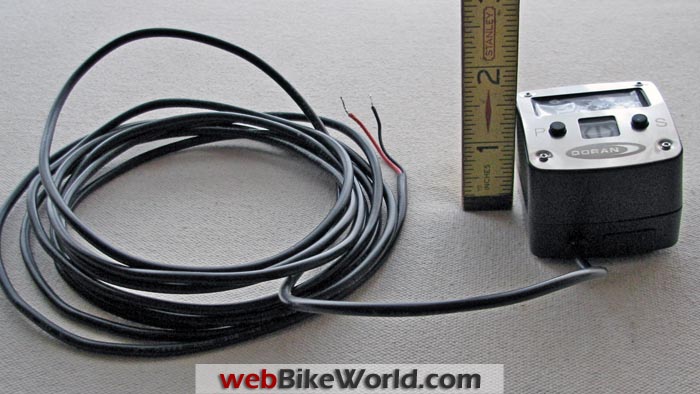
Where to Buy Doran 360M TPMS
Check Reviews & Prices on AmazonSee More: Motorcycle Accessories, Motorcycle Tire, Motorcycle Helmets
The Doran 360M: What’s in the Box
The Doran 360M TPMS kit comes in an 8″ x 9″ x 2½” box that includes two sensors. The stated weight for a sensor is 0.68 oz., but according to my scale the actual weight is even less, 14 grams (0.49 oz.).
Similarly, the specified size (1.15″ high by 1.06″ in diameter) is larger than the actual size of 0.944″ high by 1.085″ in diameter.
Perhaps the documentation refers to an older model. Keep in mind that a sensor won’t actually extend that 0.944″ beyond the end of your valve stem, because some of that length will be taken up as the sensor is threaded onto it.
As noted above, the 360M sensors do not have user-replaceable batteries.
When the battery goes (typically after 30-36 months, according to Doran) current owners can buy a new sensor from Doran for $25, which is half the per-sensor cost when buying the complete system.
[UPDATE (April 2015): As a result of additional communication with Doran, the author was told that “it does help to conserve the battery life of the sensors when you remove them from the valve stem when you’re not riding for extended periods of time.”
Thus, when parking a bike for the winter, you should remove the Doran sensors (and cut power to the control module, which is another reason to add a master on/off switch, if it’s wired to be “hot” all the time).]
Before you vent your indignation in an email to webBikeWorld, regarding spending $50 every three years, note that I spoke with a Doran representative about this.
Their position is that they considered having user-replaceable batteries, but were concerned that such things as an improperly inserted battery, mashed O-ring, or a cross-threaded cap would compromise the integrity of a sensor… and so decided against it.
The 360M kit also includes the following:
- The control module, which is 1.80″ wide, 1.97″ tall, and 1.50″ deep. It has an LCD screen (about 1.3″ wide by 0.5″ tall) for the pressure readouts, a smaller alert area, and two buttons (one to initiate the pressure display, and one for programming). A covered pair of wires, about 5 feet long, comes out the back.
- The optional alert LED. This has a pair of wires attached, terminating in a snap-in connector for the back of the control module.
- A plastic handlebar clamp, and three nicely made rubber inserts for it, for 7/8″, 1″, and 1½” diameter handlebars.
- Four optional replacement metal valve stems, two straight and two right-angle, with threads on both ends (i.e., for internal or external sensor mounting).
- Two optional sensor valve-stem lock collars, and two Allen keys for the locking bolts.
- Two double-sided sticky dots for the optional alert light and two pieces for the control module, along with some cable ties.
- A 17-page installation and usage guide (includes a copy of the one-year warranty).
Doran 360M Installation: Control Module
The Doran 360M control module snaps into its plastic handlebar clamp, you use the appropriate rubber insert, and then tighten the small bolt on the clamp.
The control module has a covered pair of wires for power, and a spot for the snap-in connector of the optional-use alert LED; if you’re not using that light, that connector area is covered with a rubber snap-in plug.
You’re told that you have two options for power: either get 12V from an always-on source (e.g., directly from the battery), or connect to a switched-with-the-ignition power source.
In either case, “the monitor is fused internally so you will not need to install a fuse in-line” we’re told in the manual, so I didn’t.
The problem with a switched power source is that you may have to wait up to six minutes after firing up the bike to get pressure readings.
That’s not acceptable to me. Remember, I want to walk over to the bike, see that the pressures are OK, and ride off.
On the other hand, if you power the unit all the time, your battery is subject to a constant current flow. This is less than 30mA, according to Doran, almost as low as a clock. I can live with that, especially since my in-the-garage dismount procedure includes hooking up a smart charger.
However, I opted for a third method, not mentioned: I wired the unit to a constant power source, but put a SPST switch in-line with the hot wire (the unit itself has no master on-off switch).
This way, if I’m ever concerned about conserving battery power – perhaps on a weeklong trip – I can simply turn off the unit overnight.
Also, when I took my bike in to get a new rear tire recently, I removed the sensors beforehand and turned the system off; that way, the installer wasn’t confronted with flashing lights during the process.
Note that I specifically chose an unlit switch, in order not to add to that 30mA parasitic drain.
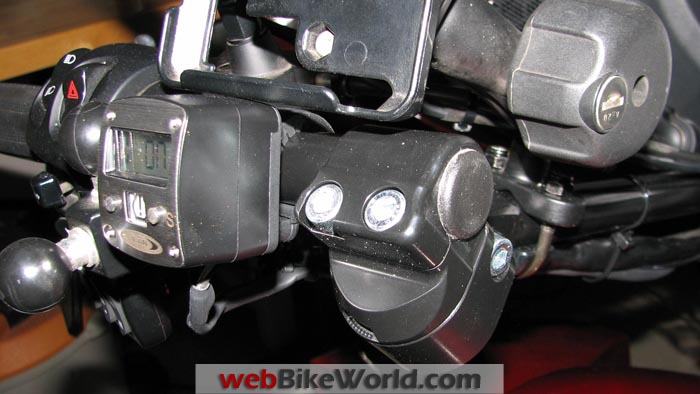
The Alert Light
You can use a sticky dot to affix the provided LED somewhere on your bike, or use a cable tie (to a mirror stalk, for instance), or ignore it. The light serves two functions.
First, it is another way to get your attention if something is amiss with your tires, i.e., in addition to the red flashing of the control module. Second, the LED allows you to dispense with the control module, at least in terms of having it in view.
For instance, you might decide to keep the control module under a locking seat, check your pressure values before you start out, and then rely solely on the LED to alert you to a problem during your ride.
If such a setup suits you, it’s not a bad idea, given that the control module is vulnerable to theft (after cutting some wires). I considered this, along with looking at some adjustable locking cradles.
In the end, I decided that we live with all sorts of possibilities of thievery and mayhem all the time.
If somebody merely “keys” your tank, it will cost you more to fix that than an entire TPMS, not to mention the possibility of having your entire bike lifted into a waiting van. So I got over it, and mounted the control module on the handlebar.
According to a representative at Doran with whom I discussed this, the company has not had a report of a stolen control module.
If it does happen, they will sell you just the module for $99, which is less than I might have spent on a locking cradle, anyway.
I did, however, replace the light, deeming it insufficiently bright for a really sunny day. I bought a “Flush Mount LED Bolt – Red, 11 mm, Black, No Lens” from Oznium.com for $5.99 (and, sigh, about the same amount for shipping).
“No Lens” does not mean that the LED is not covered; it simply means that it has a wide, not a focused, dispersal pattern, which is what you want in an alert light.
The Oznium LED is much brighter than the one provided by Doran, and is meant to be flush mounted, which is what I wanted.
I snipped the wire pair from the Doran light (near the LED end) because those wires terminated in the connector that plugs into the back of the control module.
I then enclosed the two pairs of wires coming from the module in one heat-shrink tube, and connected the stock LED wires to the short wires that come with the Oznium LED.
 The Sensors
The Sensors
As I mentioned earlier, external sensors shouldn’t be used with rubber valve stems. Doran specifically mentions this in both the user manual and in a separate sheet.
From the 360M manual: “THE DORAN 360M WIRELESS TIRE PRESSURE SENSORS SHOULD BE INSTALLED ONLY ON TIRES WITH METAL VALVE STEMS”.
And: “Installing the sensor on a rubber valve stem and/or tires with tubes can result in damage to the tire that can create a leak or blowout which could cause a sudden loss of control and result in an accident with serious injuries or loss of life”.
UPDATE (November 2014): Doran is in the process of revising its instructions.
I was told, upon contacting them, that “tires with tubes” will be acceptable for external sensors, providing the tubes have metal valve stems and those stems are securely anchored to the wheels.
The wiring taken care of, all that’s left is to screw on the sensors (hand-tight only, no tools) in place of your existing valve-stem caps. I already had metal valve stems on my Victory Cross Country Tour (review) so I didn’t use any of the four that Doran included in the 360M kit.
I also didn’t use the provided locking collars (which lock in the sense that a tiny Allen key is required to remove them).
After my early usage, it looks as if adding air will be a pretty rare event, now that I can remotely monitor the pressures. If this continues to be the case, I may change my mind about using the locks.
The wheels on my Cross Country Tour are fairly massive to begin with, and I use balance beads inside my tires, so I declared tire balance a non-issue. Whether you consider that the addition of less than half an ounce requires that you re-balance your tires is up to you.
Programming the Doran 360M
You have to do some one-time setup in the control module. This comprises telling the module how many sensors it has to look for and monitor, which sensor is where (e.g., which is the front and which the rear), the pressure units (PSI, Bar, or kPa), and your desired optimum pressure for each tire.
Since there are only two buttons on the control module, the programming involves a lot of clicking. It’s tedious, but the instructions are straight-forward and worked fine; it’s like taking a reading-comprehension test, is all.
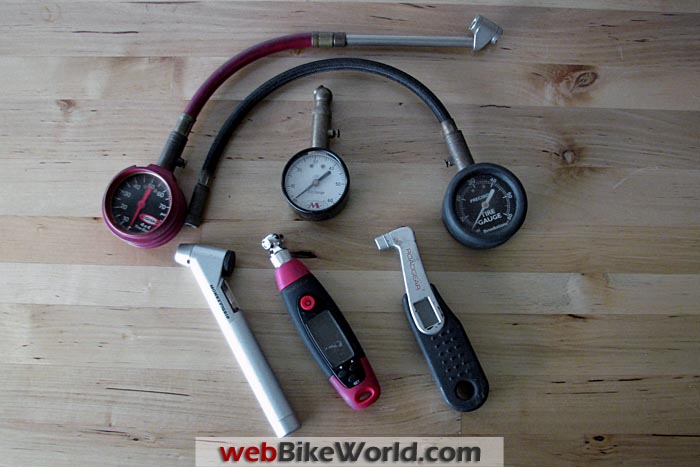
Where to Buy Doran 360M TPMS
Check Reviews & Prices on AmazonSee More: Motorcycle Accessories, Motorcycle Tire, Motorcycle Helmets
Ownar Comments and Feedback
See details on submitting comments.
From “S.S.” (April 2016): “I too was disappointed in the life of the sensors. In my case, one failed after only 13 months.
I have just re-ordered a pair for this riding season, and Doran advised me that I would be amongst the first to receive their latest ‘new and improved’ sensors, with longer lasting batteries.
$87.48 a pair is a lot to pay for sensors that have not lasted even 2 yrs. The $40 each Pressure Pro sensors I use on my RV are going on 4 years old, so the technology appears to exist.
But I chose this system for all the same reasons noted in your review, and I have experienced the value of the product when my rear tire went flat last year. The warning came in plenty of time to pull over.
Too bad Doran cant do anything about the 5 hour wait for the tow truck!
Final note: you can’t order the replacement sensors from the Doran web site, you have to call them during their business hours. Doran says that too many customers ordered the wrong type, so they pulled the product listing.
Keep up the good work testing and reviewing. The information on your website is priceless.”
From “A.C.” (January 2016): “I recently read your published article on aftermarket TPMS, one of the comments was along the lines of, ‘in this day and age all touring bikes should be fitted with TPMS’.
So far my research would suggest this may be happening, I have contacted various dealers and found that the following bikes are fitted with OE sensors, Honda, Triumph, BMW, Kawasaki, Indian and Victory.
If you know of any other makes, I would be glad to hear about them.”
Bill’s Reply: At least some of H-D’s high-end 2016 CVO models have built-in TPMS sensors, with output display on the infotainment screen (see, for instance, this article). Also, on some of its larger bikes, KTM has had TPMS available for a couple of years now.
On the other hand, while Polaris has seen fit to have TPMS on some of the more expensive Indian models, I am unaware of that option on any of its Victory models.
As I own a Victory and participate in on-line forums for the brand, I think I would have heard if Victory had added this capability.
That’s all I know about for now, but given global least-common-denominator manufacturing tendencies I’d venture that TPMS will be a requirement for all street bikes within a few years.”
From “K” (June 2015): “This is a very well written review. But I have adverse feelings about externally-mounted sensors.
The sensors continually press on the valve stem core; the only thing holding the air in, then, is the little O-ring.
The Doran TPMS reviewer states that the sensors can be mounted internally as well. Has anyone used the internal-mount scenario? In that configuration, will a usual dust cap suffice on the stem? Does the air release core function normally?
Would someone please write a follow-up review?
A friend of mine had a rapid deflation of the rear tire due to a nail picked up somewhere along our 5,000+ mile journey last year. We were less than 300 miles from home. Don’t know when the nail was picked up; but the resulting lower air pressure caused rapid tread wear.
His brand new rear tire looked like it had 50K miles on it (while the motor was lying in the bar ditch). The impression of a nail head could be seen at the puncture. The tire got so soft and thin that the bead came unseated.
This was all at 75 MPH! He was not hurt enough to go to the hospital, but his motor was totaled (Harley 2013 Limited).
Almost all of the TMPS for motorcycles mount a gizmo the size of a stack of quarters on the end of the valve stem. I want an internal monitor like new autos and some motorcycles. Don’t mind paying more for a quality product. Do not need actual air pressure and temp: an idiot warning light would do.”
Editor’s Reply: You may be looking for an Orange internal TPMS, although it’s my understanding the batteries don’t last very long.
Follow-up From “K” (June 2015): I’ve also looked into them. They’ve replaced their original unit with a new unit. M103 or something like that. And I’d be OK with batteries that last 3 years (however reviews are saying less than 9 months in some instances).
To me, it’s unconscionable in 2010 or later for motorcycle manufactures to be producing touring motorcycles without factory TPMS.
I know of several friends and friends of friends that have endured calamity when they lost their rear tire air pressure. One was killed . . . he was towing one of those small motorcycle trailers. Rear tire rapidly deflated and that was it for him.”
Response From Bill P. (June 2015): “Some comments on the recent comments on From “K” (above).
Maybe this is splitting hairs, but I don’t quite agree that, with externally mounted sensors, “the only thing holding the air in, then, is the little O-ring.” There are also the threads of the sensor.
Okay, the threads may not be completely air tight. On the other hand, you could say the same thing about a garden-variety Schrader valve: only its O-ring and maybe some threads keep the air in.
This is especially true if you have a plastic dust cap, which I don’t think will keep air in very well, all by itself; if you have a metal dust cap with a rubber seal then, granted, you may have a bit more protection against leakage than the sensor provides.
In any event, if a sensor were to unscrew itself slightly, resulting in air loss, the control module would detect the problem by giving a low-reading alarm.
If the sensor were to loosen still more, or even fall off, the normal Schrader valve would take over, preventing further loss, and the control unit would issue its sensor-not-reporting alarm (much as if you just unscrewed a sensor completely, and put it in your pocket).
At least the threaded portion of the Doran sensors appears to be hefty brass.
And this may be another argument in favor of not having user-replaceable batteries (much as I’m not enamored of the potential cost), viz., there is no screw-on plastic cap as a point of failure, should air get past the actual pressure-reading device buried inside the one-piece plastic sensor unit.
Moving on… I have not mounted the sensors internally, but I can tell you that, yes, if you do this you can then use normal valve-stem caps (although Doran includes those, too).
That is, if the sensors are mounted internally the normal external caps will not be holding in pressurized air, unlike the externally mounted sensors.
The through-the-rim valve stems that Doran includes — see the picture in the middle of the article — have normal Schrader valves on the outside portion.
(The inside portion has holes in the internal nut and apparently in that area of the valve stems, so that the sensors can read the pressure inside the rest of the tire, and some sort of thread-locker pre-applied.)
If you do choose to mount the sensors internally, Doran suggests that you then have the tire rebalanced.
There is also a cautionary description in the manual regarding how not to damage the sensors during subsequent tire changes. I, too, was concerned about battery life, which is one reason to avoid having the sensors mounted internally.
The other reason is that I don’t own tire-changing equipment, and what are the odds that I’ll be having a tire changed shortly after a sensor-battery has given up the ghost (regardless of how long they last).
Note that I have confirmed with Doran, via email after this article was published, that powering down the control module (another reason for adding a switch, the way I did) and removing the sensors over the winter would help to prolong battery life.
From Doran: “Yes, it does help to conserve the battery life of the sensors when you remove them from the valve stem when you’re not riding for extended periods of time. If they are left on the valve, the sensors will constantly read tire pressure and attempt to communicate to the monitor.”
Sorry, but I don’t know whether merely powering off the control module when not in use, but leaving the sensors in place, has any such salutary effect.
From “J” (November 2014): “Regarding the author’s comment about temperature compensation, I disagree, because the real value of having temperature compensation is that, when the tires are warm/hot, it will detect a small leak before it can turn into a possibly disastrous quick leak.
I mention this because some TPMS are sophisticated enough that they have temperature-compensating displays.
That is, if a tire was at 40 PSI when you started out, and it’s now at 50 PSI because you’re rolling right along and the temperature inside the tire is, say, 140 degrees, the display will still show 40 PSI. And maybe another function will also show you the temperature.
The theory here is that if the unit has temperature compensation, you will need to lose less air before an alert is issued. That is, without such compensation, pressure will have to first fall through the heat-expanded range, and then dip down to the threshold warning pressure.
My own belief is that this isn’t significant if your starting pressure was OK; a small leak will eventually cause an alert anyway, and a quick leak will, in most systems, trigger a separate loss-per-unit-time alert, regardless of the actual pressure numbers.
Sorry…emailed too quickly…in re-thinking, the loss-per-unit-time alert could actually even be superior to temperature compensation IF the loss-per-unit-time alert could be adjusted to be extremely sensitive so that it would detect even a very slow leak…I’ll have to read some specs on some systems to determine that.”
Bill’s Reply: Typical scenario: you start out with 42 PSI showing as your rear tire pressure. Given the heat of the day and tire flexing, especially with spirited riding, you click the Doran’s button during a ride and you see that the pressure reading is now 50.
Y’know, because the air in the tire has heated up, and per Gay-Lussac’s or Boyle’s law, the pressure has gone up, given that increase in air-inside-the-tire temperature.
Some TPMS have temp sensors, and some of those make allowances for that temp change. That is, they say, for instance (roughly): “The starting temp was 80 degrees and the pressure was 42, the temp now is 150 degrees, so, doing the math, I’ll still show a pressure of 42.”
That is, they’ll say that if the temp were lower, this is what the pressure would read, as opposed to the actual pressure.
The Doran sensors don’t have temp sensing, and so don’t do that. Instead, they just show the actual, i.e., current, pressure.
I said in the article that I felt that the lack of temp sensors was no big deal. (In fact, I find it interesting to watch this effect, pressing the show-me-the-pressures button periodically during a ride).
The writer said, initially, that this lack of compensation might be masking a slow leak.
For instance, suppose that I have a slow leak. I start riding with 42, and during the ride a reading shows, say, 46. I won’t know whether I have been riding gently — in which case 46 is what it should show — or whether I have been riding aggressively, and it should be showing 50… except that I have a slow leak.
If the Doran had temp compensation, with a slow leak it would read (during the ride), say, 40; after starting out with 42, I would know (if I checked during the ride) that something is amiss.
In his follow-up email, however, the writer recognizes that because the Doran is smart enough to alert the rider when a certain amount of air is lost over a certain amount of time, maybe all of that stuff above — about temp knowledge and compensation — isn’t such a big deal, after all.
But the writer adds: this temp ignorance would be okay only if that air-loss-per-unit-time is very sensitive.
Still with me?
Well, my position is that the Doran’s air-loss-per-unit-time warning function is not all that sensitive…but that it doesn’t need to be!
If you’re losing one or two PSI during the course of a ride, you’re not going to notice it (unless you’re a professional racer, on a race track), it won’t alter your handling in any significant matter, no harm, no foul.
If you check your pressure after letting the bike sit overnight, and (tomorrow) you see, say, 32, instead of 42, you’ll know something is wrong; actually, the Doran’s below-the-set-threshold warning light will have come on, and stayed on, overnight.
Or, if during the ride (today), that small leak enlarges itself — which would be a problem — then the Doran’s air-loss-per-unit-time warning will kick in, and you’ll stop the bike, and try to determine what’s going on.
The writer notes that he’ll “have to read some specs on some systems to determine that,” i.e., the sensitivity of some other systems, regarding air-loss-per-unit-time. I’m not sure what he’ll find, or if it will matter.
Me, I’ll stick to my original position: if a leak so small that it requires a temperature-compensated TPMS to notice it, it’s small enough not to affect a ride.
And sometime before your mount up again — or perhaps during the ride, depending on the length of the day’s ride and the size of the small leak — the low-threshold light will come on.
And the flip side will also be the case: if a leak is large enough to have an impact on the ride, the Doran will promptly alert you, because either its air-loss-per-unit-time warning or its below-the-threshold-pressure warning will kick in.
From “M.W.” (October 2014): “Question on something stated in the review (regarding the warning that motorcycle TPMS are not compatible with tube-type tires).
The motorcycle tubes I am familiar with (and use) have metal valve stems along with jam nuts and an inner cupped washer to effectively make them same as metal valve stems on tubeless wheels.
Would this not be suitable for use with the Doran system?
Tubed tires (without safety beads on the wheels) are even more in need of dynamic TPMS for safety, so it would be nice to have a system that would work with tubes.”
Bill’s Response: The problem with using an external sensor on ordinary rubber valve stems, whether using tubeless or tube-type tires, is that the torque generated by the half-ounce mass of the sensor could rip the valve stem itself or, more likely, separate it at its base from the rim or tube.
I was unfamiliar with metal valve stems on tube tires, but … I see that Dunlop, Metzeler, and others make such tubes.
Given that these stems are metal, and use jam nuts to secure them in place, I don’t see any reason why the sensors couldn’t be mounted on those types of tubes.
The important thing is that no flex is transmitted to the point at which the metal stem connects to the rubber tube, and these tubes would seem to be impervious to that.
So, live and learn, I agree with the questioner, given these particular types of inner tubes.”
UPDATE (November 2014): Bill has reported that after contacting Doran on this issue, they agree that securely anchored metal valve stems, including those terminating into tubes, are acceptable for their external sensors.
Doran states that they are “in the midst of revising our online manual and future owner’s manuals to be more clear on this subject.”
From “J.H.” (June 2014): “I wanted to drop you a note thanking you for Bill P’s article on the Doran TPMS. Very informative and superbly detailed.
It also doesn’t hurt that he was using this unit on exactly the same bike I’m riding. Rare to find articles written by anyone on a Victory. Keep up the good work!”
Other WebBikeWorld AccessoryPosts

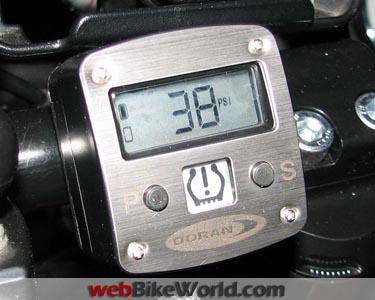
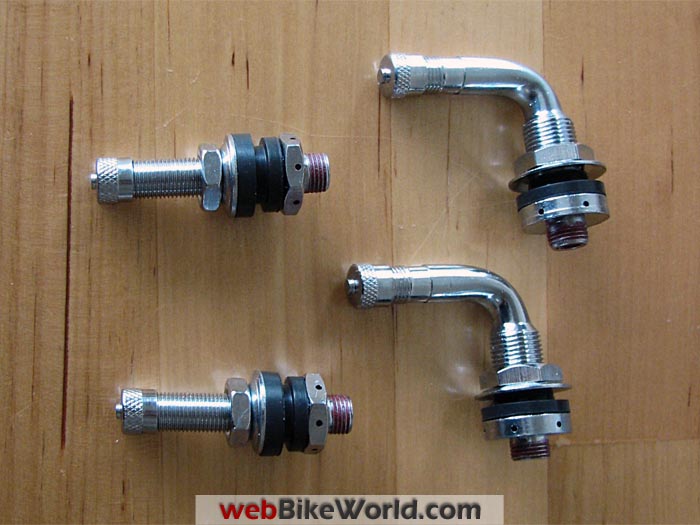 The Sensors
The Sensors
FYI the sensors are no longer available. Excuse was the vendor for the chip inside will no longer make small production runs and Doran will not order enough for a run, plus they have no backup plan. I always thought it was a bad idea to not be able to replace a $1.00 battery and be forced to buy a $50.00 sensor every few years. So I have perfectly good sensors with dead batterys. Now all the units they have sold are useless.